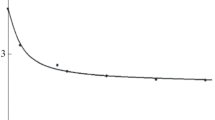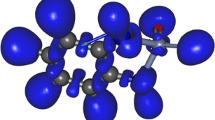Abstract
We discuss two complexes of Cr(4+) for their possible utility as models for Cr toxicity studies. They are Cr(dien)(O2)2·H2O (dien = diethylenetriamine) and Cr(NH3)3(O2)2, which have been recently characterized by x-ray diffraction and magnetic techniques. We present their optical and infrared absorption spectra as quick aids in their identification procedure. We also summarize the general properties of some well-characterized Cr(5+) compounds. All of these compounds are water soluble with the Cr(5+) samples being fairly stable in basic solutions. They can all be prepared as pure crystals with a shelf life of over 2 years when stored in a refrigerator.
Similar content being viewed by others
References
Sugden K, Martin BD: Guanine and 7,8-dihydro-8-oxo-guanine-specific oxidation in DNA by chromium(V). Environ Health Persp 110(suppl 5): 725–728, 2002
Gaggelli E, Berti F, D'Amelio N, Gaggelli N, Valensin G, Bovalini L: Metabolic pathways of carcinogenic chromium. Environ Health Persp 110(suppl 5): 733–738, 2002
Anderson RA, Polansky MM, Bryden NA, Roginski EE, Mertz W, Glinsmann W: Chromium supplementation of human subjects: Effects on glucose, insulin, and lipids variables. Metabolism 32: 894–899, 1983
Anderson RA: Nutritional factors influencing the glucose/insulin system: Chromium. J Am Coll Nutr 16: 404–410, 1997
Davis MC, Vincent JB: Chromium oligopeptide activates insulin receptor tyrosine kinase activity. Biochemistry 36: 4382–4385, 1997
Vincent JB: Biochemistry of chromium. J Nutr 130: 715–718, 2000
Vincent JB: Elucidating a biological role for chromium at molecular level. Acc Chem Res 33: 503–510, 2000
Hamilton JW, Wetterhahn KE: Chromium(VI)-induced DNA damage in chick embryo liver and blood cells in vivo. Carcinogenesis 7: 2085–2088, 1986
Kozlowski H, Swiatek J, Bal W: Chemical basis of metal-induced mutagenesis and carcinogenesis. In: B. Marcieniec, J.J. Ziolkowski (eds). Education in Advanced Chemistry, Vol. 3, Environmental Chemistry and Protection. Poznan, Wroclaw, 1998, pp 41–60.
Ye J, Shi X: Gene expression profile in response to chromium-induced cell stress in A549 cells. Mol Cell Biochem 222: 189–197, 2001
Jennette KE: EPR detection of Cr(V) in the reduction of chromate by glutathione. J Am Chem Soc 104: 874–875, 1982
Shi XL, Dalal NS: On the hydroxyl radical formation in the reaction between hydrogen peroxide and biologically generated chromium species. Arch Biochem Biophys 277: 342–350, 1990
Shi XL, Dalal NS: Chromium(V) and hydroxyl radical formation during the glutathione reductase catalyzed reduction of chromium(VI). Biophys Biochem Res Commun 163: 627–634, 1989
Vallyathan V, Mega JF, Shi XL, Pack D, Dalal NS: Enhanced generation of free radicals from phagocytes induced by mineral dusts: Am J Resp Cell Mol 6: 404–413, 1992
Shi XL, Dalal NS: On the mechanism of the chromate reduction by glutathione-electron spin resonance for the glutathionyl radical and an isolable Cr(V) intermediate. Biochem Biophys Res Commun 156: 137–142, 1988
Shi XL, Mao Y, Knapton AD, Ding M, Rojanasukul Y, Gannett PM, Dalal NS: Reaction of Cr(VI) with ascorbate and hydrogen peroxide generates hydroxyl radicals and causes DNA damage: Role of Cr(IV)-mediated Fenton-like reaction. Carcinogenesis 15: 2475–2478, 1994
Shi XL, Ding M, Ye J, Wang S, Leonard S, Zang L, Castranova V, Vallyathan V, Chiu A, Dalal NS, Liu K: Cr(IV) causes activation of nuclear transcription factor-κB, DNA strand breaks and dG hydroxylation via free radical reactions. J Inorg Biochem 75: 37–44, 1999
Liu KJ, Shi X, Dalal NS: Synthesis of a Cr(IV)-glutathione complex, its identification and free hydroxyl radical generation. Biochem Biophys Res Commun 235: 54–58, 1997
Sugden KD, Wetterhahn KE: Direct and hydrogen peroxide-induced chromium(V) oxidation of deoxyribose in single-stranded and double-stranded calf thymus DNA. Chem Res Toxicol 10: 1397–1406, 1997
Kawanishi S, Inoue S, Sano S: Mechanism of DNA cleavage by sodium chromate(VI) in the presence of hydrogen peroxide. J Biol Chem 261: 5952–5958, 1986
Connett PH, Wetterhahn KE: In vitro reaction of the carcinogen chromate with cellular thiols and carboxylic acids. J Am Chem Soc 107: 4282–4288, 1985
Liu KJ, Shi X, Jiang J, Goda F, Dalal NS, Swartz HM: Low frequency electron paramagnetic resonance investigation on metabolism of Cr(VI) in whole live mice. Ann Clin Lab Sci 26: 176–184, 1996
Ramsey C, Cage B, Nguyen P, Abboud KA, Dalal NS: Ligand dependence of magnetic dimensionality in chromium(IV) complexes: Layered vs. three-dimensional antiferromagnets. Chem Mat 15: 92–99, 2003
Cage B, Nguyen P, Dalal NS: Three-dimensional antiferromagnetism in a triaminodiperoxychromate. Solid State Commun 119: 597–601, 2001
Stomberg R: The crystal and molecular structure of diperoxotriaminechromium(IV) [Cr(O2)2(NH3)3]. Arkiv Kemi 22: 49–64, 1964
Wiede OF: Über die Synthese von chromium(IV) Komplexen. Ber.-Dtsch Chem Ges 30: 2178, 1897
House DA, Garner CS: Diperoxodiethylenetriaminechromium(IV) 1-hydrate: A new chromium(IV) peroxo compound. Nature 208: 776–777, 1965
Dalal NS, Millar JM, Jagadeesh MS, Seehra MS: Paramagnetic resonance and susceptibility of K3CrO8. J Chem Phys 74: 1916–1923, 1981
Cage B, Hasan A, Pardi L, Krzystek J, Brunel LC, Dalal NS: 375 GHz EPR measurements on undiluted Cr(V) salts. The role of exchange effects and g-strain broadening in determining the resolution in high field EPR spectroscopy of s = 1/2 paramagnets. J Magn Reson 124: 495–498, 1997
Cage B, Dalal NS: Unhydrated Cr(V) peroxychromates M3CrO8 (M = Na,K, Rb): Low-dimensional antiferromagnets exhibiting large specific heats at mK to 5 K temperatures. Chem Mat 13: 880–890, 2001
Cage B, Geyer W, Abboud KA, Dalal NS: Hydrated Cr(V) peroxychromates M3Cr O8. X H2O (M = Li, Na, Cs): Model 3d1 systems exhibiting linear chain behavior and antiferromagnetic interactions. Chem Mat 13: 871–879, 2001
Vander Griend DA, Golden JS, Arrington CA Jr: Kinetics and mechanisms of chromate reduction with hydrogen peroxide in base. Inorg Chem 41: 7042–7048, 2002
Swalen JD, Ibers JA: Chemical bonding in the perchromate ion. J Chem Phys 37: 17–20, 1962
Brown SB, Edwards JO, Herman IJ, Jones P, Mills JR, Earley JE: A kinetic and isotope study of decomposition of the tetraperoxochromate(V) ion in basic solution. Inorg Chim Acta 3:351–357, 1969
Griffith WP: Transition-metal peroxy-complexes. Part I. The violet perchromates. J Chem Soc: 3948–3954, 1962
Stomberg R: The crystal and molecular structure of diperoxoaquoethylenediaminechromium(IV) monohydrate, [Cr(O2)2(H2O)en](H2O). Arkiv Kemi 24: 47–71, 1965
Gili P, Mederos A, Lorenzo-Luis PA, de la Rosa EM, Munoz A: On the interaction of compounds of chromium(VI) with hydrogen peroxide. A study of chromium(VI) and (V) peroxides in the acid-basic pH range. Inorg Chim Acta 331: 16–24, 2002
House DA, Garner CS: The use of chromium(IV) diperoxo amines in the synthesis of chromium(III) amine complexes. I. Some monoethylenediamine and monodiethylenetriamine complexes. Inorg Chem 5: 840–844, 1966
Author information
Authors and Affiliations
Rights and permissions
About this article
Cite this article
Ramsey, C.M., Dalal, N.S. Crystalline and water soluble CR(4+) and CR(5+:) model compounds for chromium toxicity studies. Mol Cell Biochem 255, 113–118 (2004). https://doi.org/10.1023/B:MCBI.0000007267.97472.da
Issue Date:
DOI: https://doi.org/10.1023/B:MCBI.0000007267.97472.da




